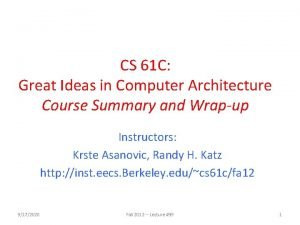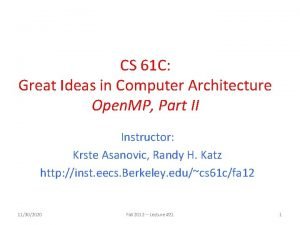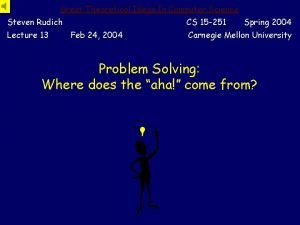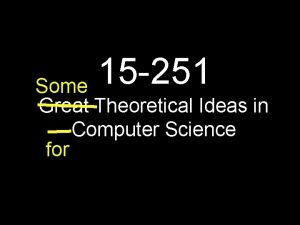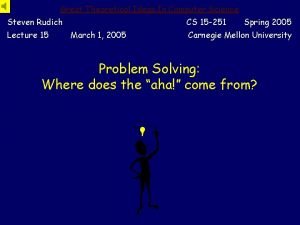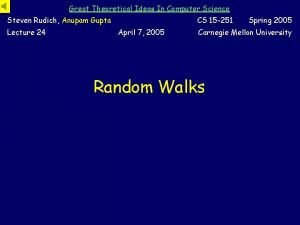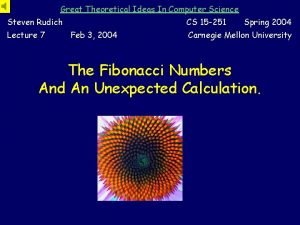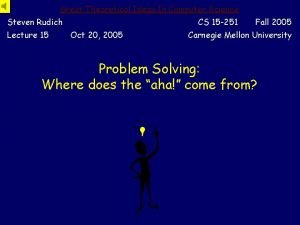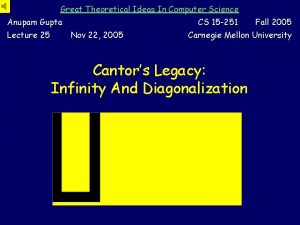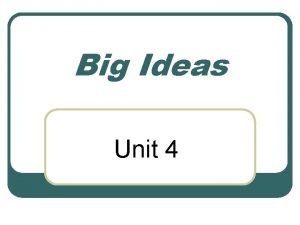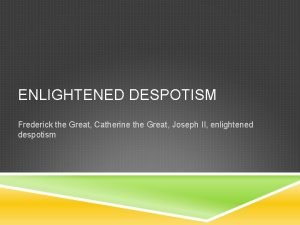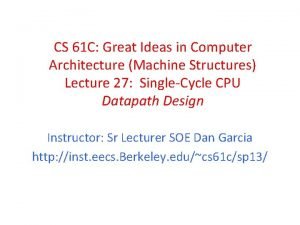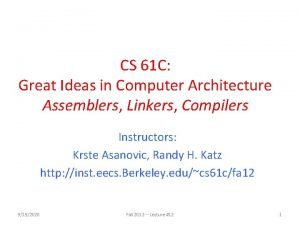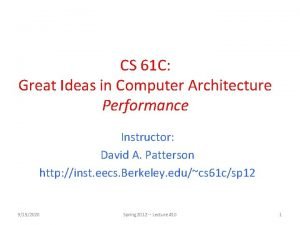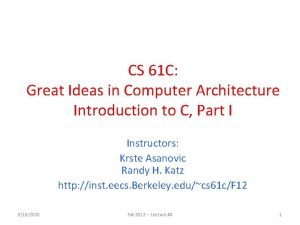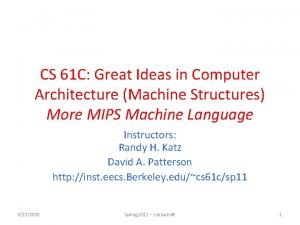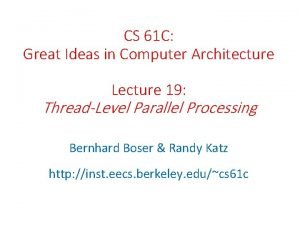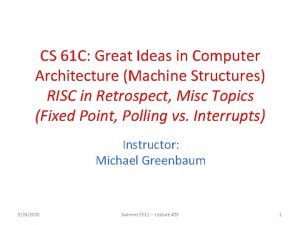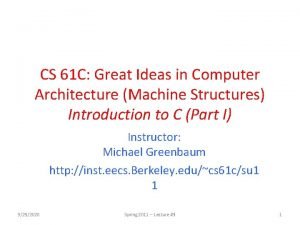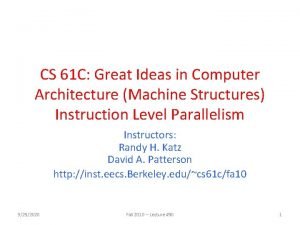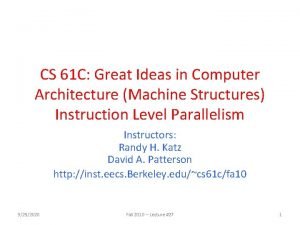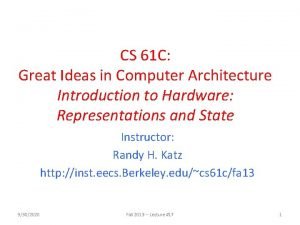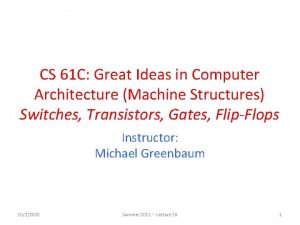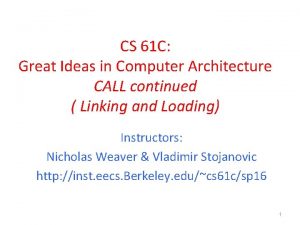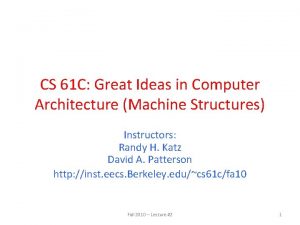CS 61 C Great Ideas in Computer Architecture




























- Slides: 28

CS 61 C: Great Ideas in Computer Architecture (Machine Structures) Set-Associative Caches Instructors: Randy H. Katz David A. Patterson http: //inst. eecs. Berkeley. edu/~cs 61 c/fa 10 9/30/2020 Fall 2010 -- Lecture #31 1

Agenda • • Cache Memory Recap Administrivia Technology Break Set Associative Caches 9/30/2020 Fall 2010 -- Lecture #31 2

Agenda • • Cache Memory Recap Administrivia Technology Break Set Associative Caches 9/30/2020 Fall 2010 -- Lecture #31 3

Recap: Components of a Computer Processor Control Devices Input Memory Datapath Output Secondary Memory (Disk) Main Memory Cache 9/30/2020 Fall 2010 -- Lecture #31 4

Recap: Typical Memory Hierarchy • Take advantage of the principle of locality to present the user with as much memory as is available in the cheapest technology at the speed offered by the fastest technology On-Chip Components Control DTLB Speed (%cycles): ½’s Size (bytes): Cost: 9/30/2020 100’s Instr Data Cache ITLB Reg. File Datapath Secondary Memory (Disk) Second Level Cache (SRAM) Main Memory (DRAM) 1’s 100’s 10, 000’s 10 K’s M’s G’s T’s highest lowest Fall 2010 -- Lecture #31 5

Recap: Cache Performance and Average Memory Access Time (AMAT) • CPU time = IC × CPI × CC = IC × (CPIideal + Memory-stall cycles) × CC CPIstall Memory-stall cycles = Read-stall cycles + Write-stall cycles Read-stall cycles = reads/program × read miss rate × read miss penalty Write-stall cycles = (writes/program × write miss rate × write miss penalty) + write buffer stalls • AMAT is the average time to access memory considering both hits and misses AMAT = Time for a hit + Miss rate x Miss penalty 9/30/2020 Fall 2010 -- Lecture #31 6

Improving Cache Performance • Reduce the time to hit in the cache – E. g. , Smaller cache, direct mapped cache, smaller blocks, special tricks for handling for writes • Reduce the miss rate – E. g. , Bigger cache, larger blocks – More flexible placement (increase associativity) • Reduce the miss penalty – E. g. , Smaller blocks or critical word first in large blocks, special tricks for handling for writes, faster/higher bandwidth memories – Use multiple cache levels 9/30/2020 Fall 2010 -- Lecture #31 7

Sources of Cache Misses: The 3 Cs • Compulsory (cold start or process migration, 1 st reference): – First access to block impossible to avoid; small effect for long running programs – Solution: increase block size (increases miss penalty; very large blocks could increase miss rate) • Capacity: – Cache cannot contain all blocks accessed by the program – Solution: increase cache size (may increase access time) • Conflict (collision): – Multiple memory locations mapped to the same cache location – Solution 1: increase cache size – Solution 2: increase associativity (may increase access time) 9/30/2020 Fall 2010 -- Lecture #31 8

Reducing Cache Misses • Allow more flexible block placement • Direct mapped $: memory block maps to exactly one cache block • Fully associative $: allow a memory block to be mapped to any cache block • Compromise: divide $ into sets, each of which consists of n “ways” (n-way set associative) to place memory block − Memory block maps to unique set determined by index field and is placed in any of the n-ways of that set – Calculation: (block address) modulo (# sets in the cache) 9/30/2020 Fall 2010 -- Lecture #31 9

Alternative Block Placement Schemes • DM placement: mem block 12 in 8 block cache: only one cache block where mem block 12 can be found—(12 modulo 8) = 4 • SA placement: four sets x 2 -ways (8 cache blocks), memory block 12 in set (12 mod 4) = 0; either element of the set • FA placement: mem block 12 can appear in any cache blocks 9/30/2020 Fall 2010 -- Lecture #31 10

Agenda • • Cache Memory Recap Administrivia Technology Break Set Associative Caches 9/30/2020 Fall 2010 -- Lecture #31 11

Late Breaking Results from Project #3, Part I MFlop/s sgemm (100000 x 500) 3 levels blocking, loop unrolling 5000 4500 4000 3500 3000 2500 2000 1500 1000 500 0 Class Data Peak Simple Blocked Thanks TA Andrew! 9/30/2020 Fall 2010 -- Lecture #31 12

Late Breaking Results from Project #3, Part I Num. Submissions sgemm (100000 x 500) Performance Histogram 35 30 25 20 15 10 5 0 0 500 1000 1500 2000 2500 3000 3500 4000 MFlop/s Thanks TA Andrew! 9/30/2020 Fall 2010 -- Lecture #31 13

Administrivia • Posted Optional Extra Logicsim “At Home” Lab this week • Project 3: TLP+DLP+Cache Opt (Due 11/13) • Project 4: Single Cycle Processor in Logicsim (by tonight) – Due Part 2 due Saturday 11/27 – Face-to-Face : Signup for 15 m time slot 11/30, 12/2 • EC: Fastest Project 3 (due 11/29) • Final Review: Mon Dec 6, 3 hrs, afternoon (TBD) • Final: Mon Dec 13 8 AM-11 AM (TBD) – Like midterm: T/F, M/C, short answers – Whole Course: readings, lectures, projects, labs, hw – Emphasize 2 nd half of 61 C + midterm mistakes 9/30/2020 Fall 2010 -- Lecture #30 14

Agenda • • Cache Memory Recap Administrivia Technology Break Set-Associative Caches 9/30/2020 Fall 2010 -- Lecture #31 15

Agenda • • Cache Memory Recap Administrivia Technology Break Set Associative Caches 9/30/2020 Fall 2010 -- Lecture #31 16

Example: 4 Word Direct Mapped $ Worst Case Reference String • Consider the main memory word reference string Start with an empty cache - all blocks initially marked as not valid 0 miss 01 00 Mem(0) 0 miss 00 01 Mem(4) 0 0 4 0 4 4 miss 4 00 Mem(0) 01 4 miss 4 00 Mem(0) 00 00 0 miss 0 01 Mem(4) 01 01 Mem(4) 4 miss 4 00 Mem(0) • 8 requests, 8 misses • Ping pong effect due to conflict misses - two memory locations that map into the same cache block 9/30/2020 Fall 2010 -- Lecture #31 18

Example: 2 -Way Set Associative $ (4 words = 2 sets x 2 ways per set) Main Memory 0000 xx One word blocks 0001 xx Two low order bits 0010 xx define the byte in the 0011 xx word (32 b words) 0100 xx 0101 xx 0110 xx 0111 xx 1000 xx Q: How do we find it? 1001 xx 1010 xx Use next 1 low order 1011 xx memory address bit to 1100 xx determine which cache 1101 xx set (i. e. , modulo the 1110 xx number of sets in the 1111 xx cache) Cache Way Set V 0 0 1 1 0 1 Tag Data Q: Is it there? Compare all the cache tags in the set to the high order 3 memory address bits to tell if the memory block is in the cache 9/30/2020 Fall 2010 -- Lecture #31 19

Example: 4 Word 2 -Way SA $ Same Reference String • Consider the main memory word reference string Start with an empty cache - all blocks initially marked as not valid 0 miss 000 Mem(0) 0 4 0 4 4 miss 0 hit 4 hit 000 Mem(0) 010 Mem(4) • 8 requests, 2 misses • Solves the ping pong effect in a direct mapped cache due to conflict misses since now two memory locations that map into the same cache set can co-exist! 9/30/2020 Fall 2010 -- Lecture #31 21

Example: Eight Block Cache with Different Organizations Total size of $ in blocks is equal to number of sets x associativity. For fixed $ size, increasing associativity decreases number of sets while increasing number of elements per set. With eight blocks, an 8 -way set-associative $ is same as a fully associative $. 9/30/2020 Fall 2010 -- Lecture #31 22

Four-Way Set Associative Cache • 28 = 256 sets each with four ways (each with one block) 31 30 . . . Tag 13 12 11 . . . 22 8 Index V Tag 0 1 2 V Tag Data Way 0 0 1 2 . . . 253 254 255 V Tag Data Way 1 0 1 2 . . . Byte offset 2 1 0 V Tag Data Way 2 0 1 2 . . . 253 254 255 Data Way 3. . . 253 254 255 32 4 x 1 select 9/30/2020 Hit Fall 2010 -- Lecture #31 Data 23

Range of Set Associative Caches • For a fixed size cache, each increase by a factor of two in associativity doubles the number of blocks per set (i. e. , the number or ways) and halves the number of sets – decreases the size of the index by 1 bit and increases the size of the tag by 1 bit Used for tag compare Tag Decreasing associativity Selects the set Index Block offset Byte offset Increasing associativity Fully associative (only one set) Tag is all the bits except block and byte offset Direct mapped (only one way) Smaller tags, only a single comparator 9/30/2020 Selects the word in the block Fall 2010 -- Lecture #31 25

Costs of Set Associative Caches • When miss occurs, which way’s block selected for replacement? – Least Recently Used (LRU): one that has been unused the longest • Must track when each way’s block was used relative to other blocks in the set • For 2 -way SA $, one bit per set → set to 1 when a block is referenced; reset the other way’s bit (i. e. , “last used”) • N-way set associative cache costs – N comparators (delay and area) – MUX delay (set selection) before data is available – Data available after set selection (and Hit/Miss decision). DM $: block is available before the Hit/Miss decision • Not possible to just assume a hit and continue and recover later if it was a miss 9/30/2020 Fall 2010 -- Lecture #31 26

Cache Block Replacement Policies • Random Replacement – Hardware randomly selects a cache item and throw it out • Least Recently Used – Hardware keeps track of access history – Replace the entry that has not been used for the longest time – For 2 -way set-associative cache, need one bit for LRU replacement • Example of a Simple “Pseudo” LRU Implementation – Assume 64 Fully Associative entries – Hardware replacement pointer points to one cache entry – Whenever access is made to the entry the pointer points to: • Move the pointer to the next entry – Otherwise: do not move the pointer Replacement Pointer 9/30/2020 Fall 2010 -- Lecture #31 Entry 0 Entry 1 : Entry 63 27

Benefits of Set Associative Caches • Choice of DM $ or SA $ depends on the cost of a miss versus the cost of implementation • Largest gains are in going from direct mapped to 2 -way (20%+ reduction in miss rate) 9/30/2020 Fall 2010 -- Lecture #31 28

3 Cs Revisted • Three sources of misses (SPEC 2000 integer and floating-point benchmarks) – Compulsory misses 0. 006%; not visible – Capacity misses, function of cache size – Conflict portion depends on associativity and cache size 9/30/2020 Fall 2010 -- Lecture #31 29

Two Machines’ Cache Parameters Intel Nehalem AMD Barcelona L 1 cache Split I$ and D$; 32 KB for organization & size each per core; 64 B blocks Split I$ and D$; 64 KB for each per core; 64 B blocks L 1 associativity 4 -way (I), 8 -way (D) set assoc. ; ~LRU replacement 2 -way set assoc. ; LRU replacement L 1 write policy write-back, write-allocate L 2 cache Unified; 256 MB (0. 25 MB) organization & size per core; 64 B blocks Unified; 512 KB (0. 5 MB) per core; 64 B blocks L 2 associativity 8 -way set assoc. ; ~LRU 16 -way set assoc. ; ~LRU L 2 write policy write-back, write-allocate L 3 cache Unified; 8192 KB (8 MB) organization & size shared by cores; 64 B blocks Unified; 2048 KB (2 MB) shared by cores; 64 B blocks L 3 associativity 16 -way set assoc. 32 -way set assoc. ; evict block shared by fewest cores L 3 write policy write-back, write-allocate write-back; write-allocate 9/30/2020 Fall 2010 -- Lecture #31 30

Summary • Name of the Game: Reduce Cache Misses – Two different memory blocks mapping to same cache block could knock each other out as program bounces from one memory location to the next • One way to do it: set-associativity – Memory block maps into more than one cache block – N-way: n possible places in the cache to hold a given memory block – N-way Cache of 2 N+M blocks: 2 N ways x 2 M sets 9/30/2020 Fall 2010 -- Lecture #31 31
 Eight great ideas in computer architecture
Eight great ideas in computer architecture Cs61c fall 2020
Cs61c fall 2020 Cs61c
Cs61c 8 great ideas in computer architecture
8 great ideas in computer architecture Great theoretical ideas in computer science
Great theoretical ideas in computer science Great ideas in theoretical computer science
Great ideas in theoretical computer science Great theoretical ideas in computer science
Great theoretical ideas in computer science Cse 111
Cse 111 15 251
15 251 Great theoretical ideas in computer science
Great theoretical ideas in computer science Great theoretical ideas in computer science
Great theoretical ideas in computer science Great theoretical ideas in computer science
Great theoretical ideas in computer science Great theoretical ideas in computer science
Great theoretical ideas in computer science Great theoretical ideas in computer science
Great theoretical ideas in computer science Great theoretical ideas in computer science
Great theoretical ideas in computer science Bus architecture in computer organization
Bus architecture in computer organization Difference between architecture and organization
Difference between architecture and organization Fgi and fgo in computer architecture
Fgi and fgo in computer architecture Ideas have consequences bad ideas have victims
Ideas have consequences bad ideas have victims Los deseos ridículos preguntas y respuestas
Los deseos ridículos preguntas y respuestas China big idea
China big idea Turning great strategy into great performance
Turning great strategy into great performance Great places great faces south dakota
Great places great faces south dakota With great power comes great responsibility voltaire
With great power comes great responsibility voltaire Great white shark and hammerhead shark
Great white shark and hammerhead shark Did alexander the great deserve to be called great
Did alexander the great deserve to be called great Enlightened despot catherine
Enlightened despot catherine With great expectations comes great responsibility
With great expectations comes great responsibility A great deal vs a great many
A great deal vs a great many

